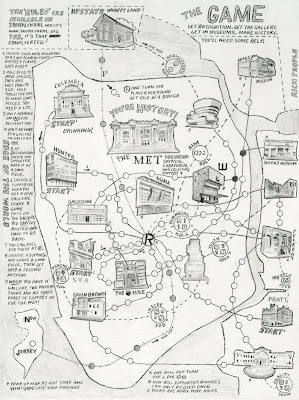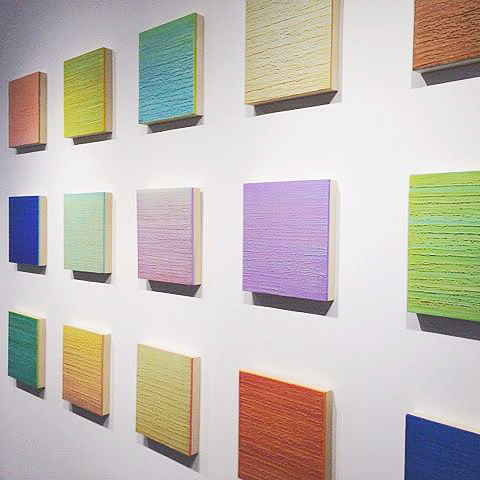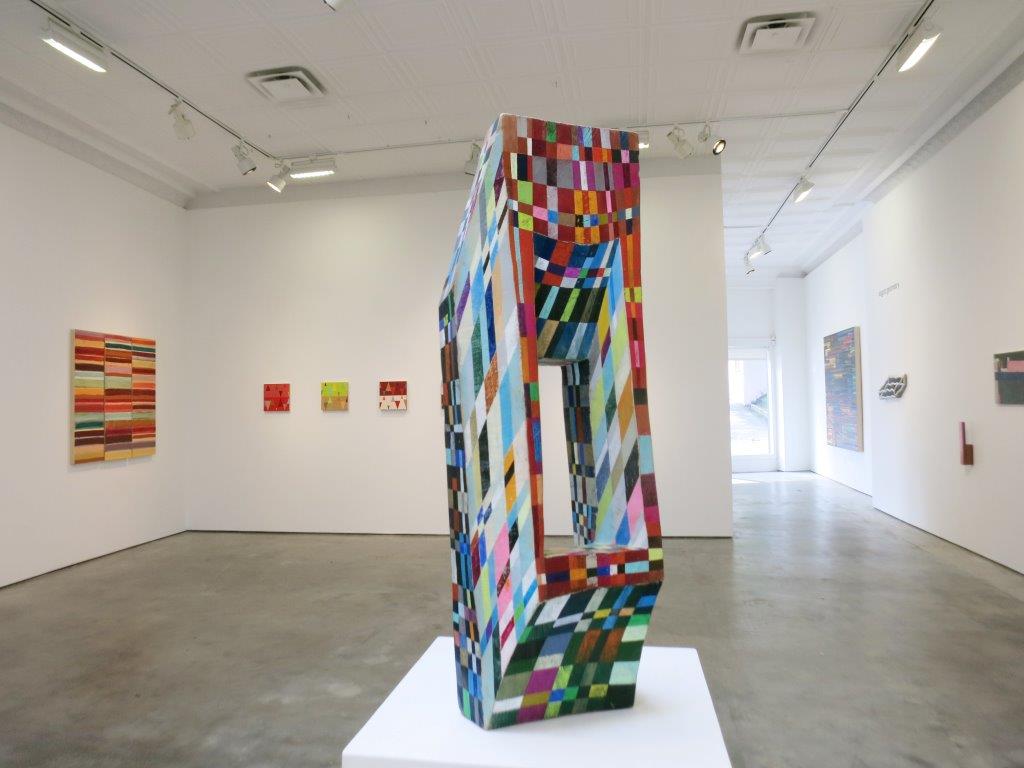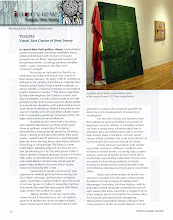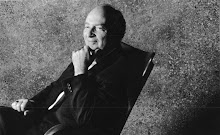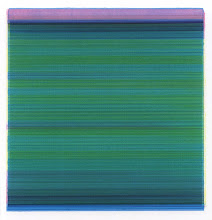.
Early in my career I showed in a number of academic galleries. In addition to the wonderful opportunity they gave a then-emerging artist like me to exhibit as a solo artist, I learned what it took to create an exhibition: how to plan my time in the studio, how to think about the relationship of the work to the space in which it would go, how to prepare the supporting materials—resume, statement, eventually brochures and catalogs. Crucially, at the other end, by working with and watching the gallery director, I came to understand what it took to get my work onto the wall: how to plan a cohesive installation, how to actually install it, how to promote the exhibition and then follow up with the press. At the openings I learned how to talk about myself and my work. .
.

.
A 2007 solo of my work, curated by Leonie Bradbury and Shana Dumont, for an art college in Massachusetts
.
.
.
Armed with this information and experience, I then focused on commercial galleries and museums and didn’t look back. Until recently. I’ve come to appreciate the importance of academic galleries, not only for emerging artists but for artists at all levels of their career.
I’ll give you a few specifics. In 2004 I had a solo show at the Winfisky Gallery of Salem State College in Massachusetts, just north of Boston. Benjamin Gross, the gallery director, gave me free reign, so I proposed Ten Years of Encaustic Painting. I’m not likely to get a retrospective at MoMA, so I rounded up a decade's worth of paintings for the show, and Ben and I created a catalog.
.
Many good things came from that show and catalog: a small review in the Boston Globe, and a couple of good shows here in New York City—a terrific thematic summer show with a great group of artists at the Elizabeth Harris Gallery, followed by a solo at OK Harris, where I'd had a solo a dozen years earlier, along with another thematic show there. These opportunities came as a result of the catalog and supporting materials I'd sent to the directors.
.
Several other academic shows were interspersed among my commercial exhibitions. In 2006, I showed in Luminous Depths, curated by Nancy Einreinhofer, at the Ben Shahn Gallery of Wm. Patterson University in Wayne, New Jersey. It’s a beautiful space. There was a catalog, and work from that show was included in Material Color at the Hunterdon Art Museum in Clinton, New Jersey, a few years later. (See how the dots connect?) Serendipitously, the painter Merrill Wagner and her husband Robert Ryman were at her opening in the adjacent gallery, and many dealers stopped in to see the show. In 2007 I had a lovely small solo at an art college in Massachusetts. I got to show among my peers, and as a result of the show, I traded a good-size painting with a paint manufacturer for a good deal of paint.
 Luminous Depths, curated by Nancy Einreinhofer for the Ben Shahn Galleries at Wm. Paterson University, Wayne, New Jersey. This panoramic view shows the work of most of the participating artists: Foreground, Sylvia Netzer; clockwise around the gallery: Rachel Friedberg on the left wall, my installation grid on the back wall, Diana Gonzalez Gandolfi and Megan Klim on the right wall
Luminous Depths, curated by Nancy Einreinhofer for the Ben Shahn Galleries at Wm. Paterson University, Wayne, New Jersey. This panoramic view shows the work of most of the participating artists: Foreground, Sylvia Netzer; clockwise around the gallery: Rachel Friedberg on the left wall, my installation grid on the back wall, Diana Gonzalez Gandolfi and Megan Klim on the right wall
.
Below: Netzer in foreground, Gail Gregg on both walls. Read more about the exhibition here
.

My Story is Just the Prologue to this Post
Earlier this year I asked the directors of two academic galleries, both within liberal arts institutions, to talk to me about the role of the academic gallery. I was thinking specifically about the value to artists of showing in such venues, but reading their email responses, I realized that the topic is larger than just showing. So this is a two-parter, to be continued next week.
.
Our experts: Patricia Miranda, artist, educator, and director of the OSilas Gallery at Concordia College in Bronxville, New York; and Jane Allen Nodine, artist, professor of art, and director of the Curtis R. Harley Gallery at the University of South Carolina Upstate, in Spartanburg, South Carolina. Both directors responded so clearly and informationally that I have decided to run the piece as a Q&A with minimal redaction.
.
What do you think the artist gets out of an exhibition at an academic gallery?
Nodine: I schedule exhibitions a year in advance. Artists are selected on the basis of work I have seen, but they are encouraged to develop new work for the show. In some cases an artist may have new or experimental ideas, and I am willing to work with them to realize that new direction. In more monetary or pragmatic terms, we design and print a color announcement that is mailed to about 700 venues across the United States. We sponsor a lecture or gallery talk by the visiting artist, followed by a public reception. We pay each artist a stipend, and our communications office promotes the exhibit in the media. Work can be for sale in our gallery, but I encourage the buyer to work directly with the artist because we take no commission.
.
Miranda: The OSilas Gallery does not have a collection; still, it is a museum quality gallery, with a gorgeous space not generally found in such a small institution. Our exhibits offer artists a beautiful space to show work, but also a unique opportunity to introduce themselves and their work to an audience perhaps outside a typical art community. In our last gallery talk, the artists and curator noted how much they enjoyed speaking to people outside their own community, and how interested and engaged people were at what they had to say despite not being familiar with their work. University galleries can introduce artists to the community and vice versa, and make connections that are meaningful to the exhibition and to their work.
.
 Jane Allen Nodine: "Our gallery mission is to present challenging material that supports the academic programs which are the foundation of the University, and the University mission includes ties to the community and life-long learning. So, by default and by design, I make an effort to integrate these concepts into our schedule our events."
Jane Allen Nodine: "Our gallery mission is to present challenging material that supports the academic programs which are the foundation of the University, and the University mission includes ties to the community and life-long learning. So, by default and by design, I make an effort to integrate these concepts into our schedule our events."
.
 Patricia Miranda: "Exhibitions in academic institutions are often willing to give artists leeway to explore and develop larger ideas, further their work, and give them a forum for this exploration."
Patricia Miranda: "Exhibitions in academic institutions are often willing to give artists leeway to explore and develop larger ideas, further their work, and give them a forum for this exploration."
Above, view of the Spring 2010 exhibition, A Delicate Point: Images from a South Asian Diaspora, curated by Miranda and Priyanka Mathew
.
A talk during A Delicate Point draws many members of the art community as well as the community at large

.
.
And is there a larger benefit to showing within the institution?
Nodine: Association with an academic venue adds credibility and validation to an artist’s record. We have coordinated exhibits with other departments in the university such as Women’s Studies, Sociology, and International Studies, which can extend into paying workshops or seminars. Also academicians survive on the publication of their research; an exhibit can draw a faculty or grad student to write critically about work, writing that might get published.
.
Miranda: I think exhibitions in academic institutions are often willing to give artists leeway to explore and develop larger ideas, further their work, and give them a forum for this exploration. Work that might not be considered for a commercial setting, whether because it is not object-based, does not fill a more commercial purpose or is more conceptual may find a place in an academic setting. That's true, too, for the an artist doing good work but who has yet to be recognized. This has been my experience both as artist and as curator. I think academic galleries are a wonderful place to exhibit work!
.
How do you select the artists for your gallery shows?
Nodine: I‘m always on the lookout for art, artists, or topics for exhibitions in the gallery. Someone I met four years ago may not have been selected at that time, but now might be doing just what I need for a particular show. Looking back at the artists I have exhibited, it appears I have personally known about 40 percent. The other 60 percent have come to the gallery in various ways: I have followed their careers, seen work in exhibitions, or had them recommended by another professional. I do get packets and proposals, but I usually follow an artist for a time before I schedule an exhibit. I make selections based on the content and quality of work, and I try to schedule a variety of media and art forms throughout our exhibition season. Our gallery mission is to present challenging material that supports the academic programs which are the foundation of the University, and the University mission includes ties to the community and life-long learning. So, by default and by design, I make an effort to integrate these concepts into our schedule our events.
.
Miranda: The OSilas Gallery focuses on a wide range of thematic group exhibitions, connecting the gallery to the larger campus and academic community. I plan the themes for exhibitions, based on ideas I am interested in or ones proposed to me, considering the year’s program as a kind of “year of ideas”. The curator of each exhibition, which might be myself, or someone I have contracted to curate a particular show, chooses artists. I love to look at work sent to me by artists and will keep work on file for possible future shows. On occasion we may do a solo or two-person exhibition, but primarily we mount group shows.
.
I plan about two years in advance, so artists who have ideas for exhibitions or who send a package should keep that in mind. It is always good to keep us current with upcoming shows. Even though it can be difficult to respond to every package or request--like most non-profits and commercial spaces we are on a very tight schedule and work with really limited staff--I do keep info and really do look at work that comes in.
.
In Part 2: The directors offer advice to artists thinking about submitting work to an academic gallery, and we look at how the academic gallery fits into the larger community.
.
Over to you: Have you shown in an academic gallery? Do you direct one? Do you visit academic galleries? Are you interested in showing in one?
 Bathers by a River, 1909–10, 1913, 1916–17; oil on canvas, 102 1/2 x 154 3/16". The Art Institute of Chicago, Charles H. and Mary F. S. Worcester Collection. © 2010 Succession H. Matisse/Artists Rights Society (ARS),
Bathers by a River, 1909–10, 1913, 1916–17; oil on canvas, 102 1/2 x 154 3/16". The Art Institute of Chicago, Charles H. and Mary F. S. Worcester Collection. © 2010 Succession H. Matisse/Artists Rights Society (ARS), 



















+of+i%2520love%2520stalking.jpg)
